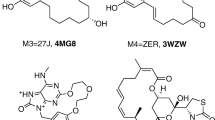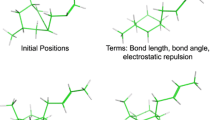Abstract
We have determined the effects that tightly bound water molecules have on the de novo design of cyclin-dependent kinase-2 (CDK2) ligands. In particular, we have analyzed the impact of a specific structural water molecule on the chemical diversity and binding mode of ligands generated through a de novo structure-based ligand generation method in the binding site of CDK2. The tightly bound water molecule modifies the size and shape of the binding site and we have found that it also imposed constraints on the observed binding modes of the generated ligands. This in turn had the indirect effect of reducing the chemical diversity of the underlying molecular scaffolds that were able to bind to the enzyme satisfactorily.





Similar content being viewed by others
References
Davis AM, Teague SJ, Kleywegt GJ (2003) Angew Chem Int Ed 42:2718-2736
Poornima CS, Dean PM (1995) J Comput-Aided Mol Des 9:500–512
Hendlich M, Bergner A, Günter J, Klebe G (2003) J Mol Biol 326:607–620
Chung E, Henriques D, Renzoni D, Zvelebil M, Bradshaw JM, Waksman G, Robinson CV, Ladbury JE (1998) Struct Fold Des 6:1141–1151
Rejto PA, Verkhivker GM (1997) Proteins Struct Funct Genet 28:313–324
Wester MR, Johnson EF, Marques-Soares C, Dijols S, Dansette PM, Mansuy D, Stout CD (2003) Biochem 42:9335–9345
Marrone TJ, Briggs JM, McCammon JA (1997) Ann Rev Pharmacol Toxicol 37:71–90
Lam PYS, Jadhav PK, Eyermann CJ, Hodge CN, Ru Y, Bacheler LT, Meek JL, Otto MJ, Rayner MM, Wong YN, Chang CH, Weber PC, Jackson DA, Sharpe TR, Ericksonviitanen S (1994) Science 263:380–384
Chen JM, Xu SL, Wawrzak Z, Basarab GS, Jordan DB (1998) Biochem 37:17735–17744
Mikol V, Papageorgiou C, Borer X (1995) J Med Chem 38:3361–3367
Cherbavaz DB, Lee ME, Stroud RM, Koschl DE (2000) J Mol Biol 295:377–385
Finley JB, Atigadda VR, Duarte F, Zhao JJ, Brouillette WJ, Air GM, Luo M (1999) J Mol Biol 293:1107–1119
Rarey M, Kramer B, Lengauer T (1998) Proteins Struct Funct Genet 34:17–28
Schnecke V, Kuhn LA (2000) Perspect Drug Discov Des 20:171–190
Pospisil P, Kuoni T, Scapozza L, Folkers G (2002) J Recept Signal Transduct Res 22:141–154
Pastor M, Cruciani G, Watson KA (1997) J Med Chem 40:4089–4102
Lloyd DG, García-Sosa AT, Alberts IL, Todorov NP, Mancera RL (2004) J Comput-Aided Mol Des 18:89–100
Mancera RL (2002) J Comput-Aided Mol Des 16:479–499
Todorov NP, Dean PM (1998) J Comput-Aided Mol Des 12:335–349
Stahl M, Todorov NP, James T, Mauser H, Boehm H-J, Dean PM (2002) J Comput-Aided Mol Des 16:459–478
Gray NS, Wodicka L, Thunissen A-MWH, Norman TC, Kwon S, Espinoza FH, Morgan DO, Barnes G, LeClerc S, Meijer L, Kim S-H, Lockhart DJ, Schultz PG (1998) Science 281:533–538
Knockaert M, Greengard P, Meijer L (2002) Trends Phamacol Sci 23:417–425
Metz WA (2003) Bioorg Med Chem Lett 13:2953–2953
Beattie JF, Breault GA, Ellston RPA, Green S, Jewsbury PJ, Midgley CJ, Naven RT, Minshull CA, Pauptit RA, Tucker JA, Pease JE (2003) Bioorg Med Chem Lett 13:2955–2960
Breault GA, Ellston RPA, Green S, James SR, Jewsbury PJ, Midgley CJ, Pauptit RA, Minshull CA, Tucker JA, Pease JA (2003) Bioorg Med Chem Lett 13:2961–2966
Anderson M, Beattie JF, Breault GA, Breed J, Blyth KF, Culshaw JD, Ellston RPA, Green S, Minshull CA, Norman RA, Pauptit RA, Stanway J, Thomas AP, Jewsbury PJ (2003) Bioorg Med Chem Lett 13:3021–3026
Westwell AD (2003) Drug Discov Today 8:1094–1095
McGovern SL, Shoichet BK (2003) J Med Chem 46:1478–1483
Sayle KL, Bentley J, Boyle FT, Calvert AH, Cheng YZ, Curtin NJ, Endicott JA, Golding BT, Hardcastle IR, Jewsbury PJ, Mesguiche V, Newell DR, Noble MEM, Parsons RJ, Pratt DJ, Wang LZ, Griffin RJ (2003) Bioorg Med Chem Lett 13:3079–3082
Moravec J, Krystof V, Hanus J, Havlicek L, Moravcova D, Fuksova K, Kuzma M, Lenobel R, Otyepka M, Strnad M (2003) Bioorg Med Chem Lett 13:2993–2996
Berman HM, Westbrook J, Feng Z, Gilliland G, Bhat TN, Weissig H, Shindyalov IN, Bourne PE (2000) Nucl Acids Res 28:235–242
Shewchuk L, Hassell A, Wisely B, Rocque W, Holmes W, Veal J, Kuyper LF (2000) J Med Chem 43:133–138
Pierce AC, Sandretto KL, Bemis GW (2002) Proteins Struct Funct Genet 49:567–576
Todorov NP, Dean PM (1997) J Comput-Aided Mol Des 11:175–192
Dinur U, Hagler AT (1991) In: Lipkowitz KB, Boyd DB (eds) Reviews in Computational Chemistry, vol 2. VCH Publishers Inc, USA
García-Sosa AT, Mancera RL, Dean PM (2003) J Mol Model 9:172–182
Kríz Z, Otyepka M, Bártová I, Koca J (2004) Proteins Struct Funct Bioinf 55:258–274
Krystof V, Strnad M (2001) Chem Listy 95:295–300
Davies TG, Pratt DJ, Endicott JA, Johnson LN, Noble MEM (2002) Pharmacol Therap 93:125–133
Hardcastle IR, Golding BT, Griffin RJ (2002) Annu Rev Pharmacol Toxicol 42:325–348
Gibson AE, Arris CE, Bentley J, Boyle T, Curtin NJ, Davies TG, Endicott JA, Golding BT, Grant S, Griffin RJ, Jewsbury P, Johnson LN, Mesguiche V, Newell DR, Noble MEM, Tucker JA, Whitfield HJ (2002) J Med Chem 45:3381–3393
Schulze-Gahmen U, De Bondt HL, Kim S-H (1996) J Med Chem 39:4540–4546
Misra RN, Xiao H, Kim KS, Han W-C, Barbosa SA, Hunt JT, Rawlins DB, Shan W, Ahmed SZ, Qian L, Chen B-C, Zhao R, Bednarz MS, Kellar KA, Mulheron JG, Batorsky R, Roongta U, Kamath A, Marathe P, Ranadive SA, Sack JS, Tokarski JS, Pavletich NP, Lee FYF, Webster KR, Kimball SD (2004) J Med Chem 47:1719–1728
de Azevedo WF, Mueller-Dieckman H-J, Schulze-Gahmen U, Worland PJ, Sausville EA, Kim SH (1996) Proc Natl Acad Sci USA 93:2735–2740
Schulze-Gahmen U, Brandsen J, Jones HD, Morgan D, Meijer L, Vesely J, Kim S-H Proteins Struct Funct Genet 22:378–391
Acknowledgements
ATGS is grateful to Consejo Nacional de Ciencia y Tecnología (CoNaCyT, México) for the award of a post-graduate scholarship and to the Universities UK for an Overseas Research Scheme award. The authors would like to thank Dr. Nikolay P. Todorov, Dr. Stuart Firth-Clark and Dr. Christoph Buenemann for helpful and fruitful discussions.
Author information
Authors and Affiliations
Corresponding authors
Rights and permissions
About this article
Cite this article
García-Sosa, A.T., Mancera, R.L. The effect of a tightly bound water molecule on scaffold diversity in the computer-aided de novo ligand design of CDK2 inhibitors. J Mol Model 12, 422–431 (2006). https://doi.org/10.1007/s00894-005-0063-1
Received:
Accepted:
Published:
Issue Date:
DOI: https://doi.org/10.1007/s00894-005-0063-1




